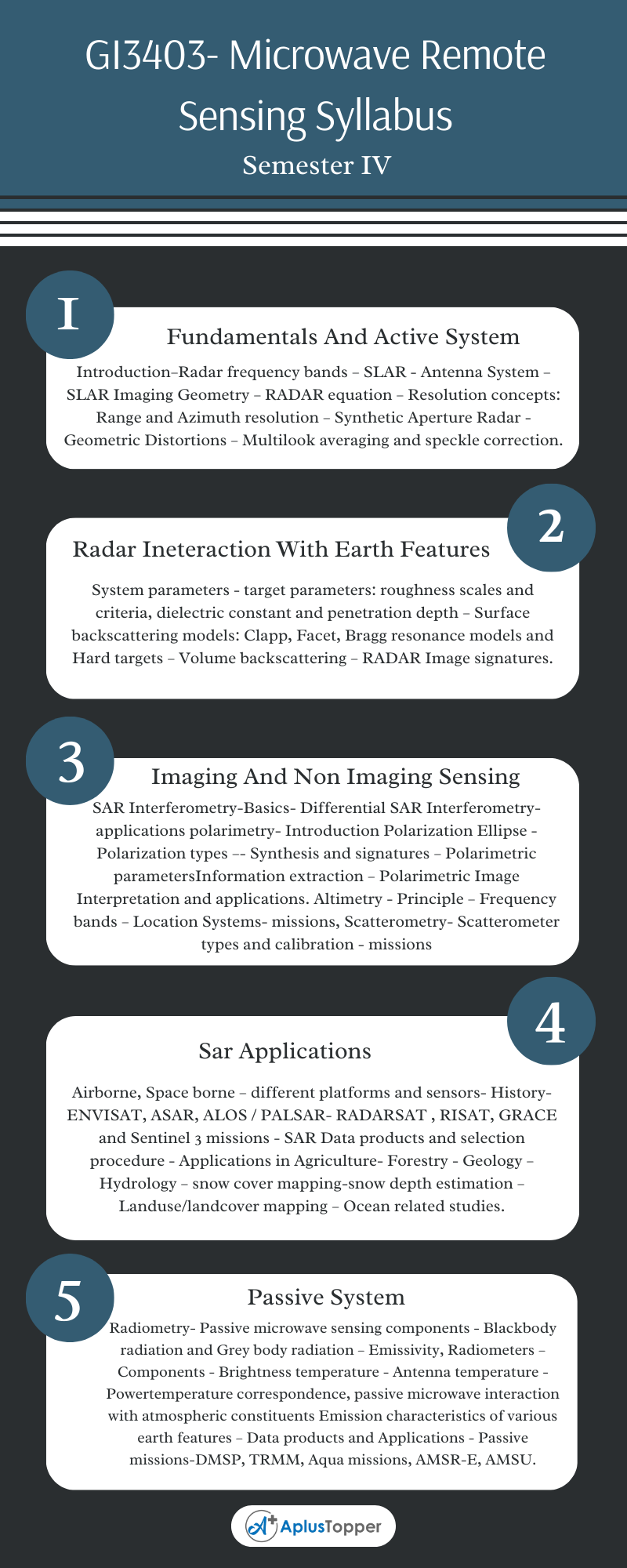GI3403 Subject code deals with the semester IV Subject Microwave Remote Sensing syllabus of Anna University 2021 Revised regulation syllabus of B.E Geo Informatics Engineering. It is provided based on the student’s point of view to prepare well for academic examinations.
In this article, we would like to discuss the GI3403 – Microwave Remote Sensing Syllabus. To get good marks in the academic examinations, need a certain guide to assist you with the chapter-wise syllabus right? We include the chapter-wise syllabus for students, to assist them simply. A clear picture of the syllabus in your mind helps to understand the topics from every unit or chapter.
Then you will get an idea of where to begin from the whole syllabus by separating the topics easy from hard topics. Having command of the subject syllabus makes it easy to revise the syllabus for examination and helps you to excel in academics. The following article will give you sufficient information regarding the syllabus. Don’t forget to share it with your friends.
If you want to know more about the syllabus of B.E Geo-Informatics Engineering connected to affiliated institutions under a four-year undergraduate degree program. We provide you with a detailed Year-wise, semester-wise, and Subject-wise syllabus in the following link B.E Geo-Informatics Engineering Syllabus Anna University, Regulation 2021. Hoping this information is useful to you.
Aim Of Concept:
- To impart the knowledge on Microwave Remote Sensing and its applications.
GI3403- Microwave Remote Sensing Syllabus
Unit I: Fundamentals And Active System
Introduction–Radar frequency bands – SLAR – Antenna System – SLAR Imaging Geometry – RADAR equation – Resolution concepts: Range and Azimuth resolution – Synthetic Aperture Radar – Geometric Distortions – Multilook averaging and speckle correction.
Unit II: Radar Ineteraction With Earth Features
System parameters – target parameters: roughness scales and criteria, dielectric constant and penetration depth – Surface backscattering models: Clapp, Facet, Bragg resonance models and Hard targets – Volume backscattering – RADAR Image signatures.
Unit III: Imaging And Non-Imaging Sensing
SAR Interferometry-Basics- Differential SAR Interferometry-applications polarimetry- Introduction Polarization Ellipse – Polarization types –- Synthesis and signatures – Polarimetric parametersInformation extraction – Polarimetric Image Interpretation and applications. Altimetry – Principle – Frequency bands – Location Systems- missions, Scatterometry- Scatterometer types and calibration – missions
Unit IV: Sar Applications
Airborne, Space borne – different platforms and sensors- History- ENVISAT, ASAR, ALOS / PALSAR- RADARSAT, RISAT, GRACE and Sentinel 3 missions – SAR Data products and selection procedure – Applications in Agriculture- Forestry – Geology –Hydrology – snow cover mapping-snow depth estimation – Landuse/landcover mapping – Ocean related studies.

Unit V: Passive System
Radiometry- Passive microwave sensing components – Blackbody radiation and Grey body radiation – Emissivity, Radiometers – Components – Brightness temperature – Antenna temperature – Powertemperature correspondence, passive microwave interaction with atmospheric constituents Emission characteristics of various earth features – Data products and Applications – Passive missions-DMSP, TRMM, Aqua missions, AMSR-E, AMSU.
Textbooks:
- Ulaby, F.T., Moore, R.K, Fung, A.K, “Microwave Remote Sensing; active and passive, Vol. 1,2 and 3, Addison – Wesley publication company, 2001.
- John R. Jensen,” Remote Sensing of the Environment: An Earth Resource Perspective”, Pearson Education India, 2013.
- John A. Richards,” Remote Sensing with Imaging RADAR”, Springer,2009.
References:
- Prashant Srivastava, Dillep Gupta, Tanvir Islam, Dawei Han, Rajendra Prasad,” RADAR Remote Sensing Application and Challenges”, Elsevier,2022.
- Pranab Kumar Karmakar Microwave Propagation And Remote Sensing Atmospheric Influences With Models And Applications, Taylor & Francis, CRC Press, 2020
- Alessandro Ferretti ,”Satellite InSAR data: Reservoir monitoring from Space”, EAGE Publications, 2014.
- Jhon R.Schott, Fundamentals of Polarimetric Remote Sensing, SPIE Press, 2010
- Woodhouse lain. H, “Introduction to Microwave Remote Sensing” Taylor & Francis, 2006.
Related Posts On Semester – IV:
- GI3401 – Sensors and Data products
- GI3402 – Digital Image Processing
- GI3491 – Cartography and GIS
- GI3492 – Total Station and GPS Surveying
